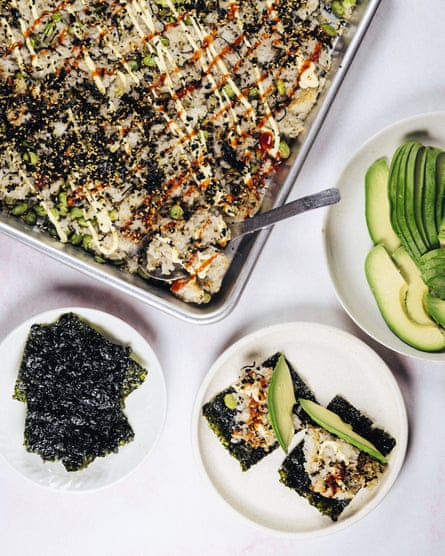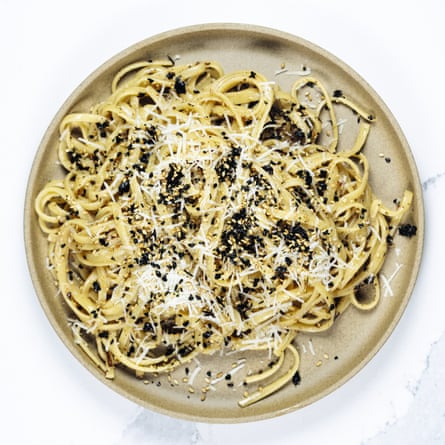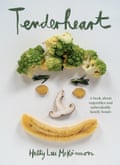
Hijiki baked rice wrapped in nori
You could call these lazy sushi rice rolls, or seaweed rice tacos, but we eat some iteration of this meal at least once a fortnight (which is a lot in our family, as we have a huge repertoire of favourites).
The beauty of this dish is that it requires zero thought, it’s nutritious and filling, and it can be topped with whatever vegetables you have on hand. Cucumber or raw zucchini are nice toppings, but you could also add sweetcorn, pan-fried mushrooms, wilted spinach and more. Seaweed snacks, the small sheets of salty, crispy nori, are a staple in our house and they add a fun, cheeky element to this meal.
Serves 4
6g dried hijiki, soaked in 750ml of hot water
900g cooked white or brown rice (from 400g uncooked)
2 tbsp rice vinegar
1 tbsp roasted sesame oil
1 tsp sea salt
1 tsp white sugar
140g podded edamame beans
Extra-virgin olive oil or neutral oil
Kewpie, regular or vegan mayonnaise
Sriracha chilli sauce or hot sauce
Furikake or vegan furikake
4 packs roasted seasoned seaweed snacks
1 avocado, sliced
Preheat the oven to 230C.
Drain the hijiki in a fine sieve and rinse with cold water. Drain again, then transfer to a large bowl. Add the rice, rice vinegar, sesame oil, sea salt and sugar and mix to combine. Add the edamame beans and fold them through.
Drizzle a deep baking tray (about 43centimetres by 30 centimetres) with oil and add the rice mixture, pressing it down so it is spread right to the corners and edges. Place in the oven and bake for 20 to 25 minutes, until there are a few golden spots on top of the rice. Remove from the oven.
If you’re using regular mayonnaise, add a splash of water (just one to two teaspoons should do it) to make it more pourable. Spoon or drizzle the mayonnaise (I like Kewpie brand the best) over the rice in a zigzag fashion, and then do the same with the sriracha chilli sauce or hot sauce. Scatter the furikake all over the surface.
Serve with the seaweed snacks and avocado on the side. To eat, place a scoop of rice on a sheet of seaweed, add a slice of avocado and roll it up.
Seaweed burnt butter pasta

Consider this a gateway recipe for seaweed sceptics. Dulse, in this recipe, is a red lettuce-like leaf that grows wild on the shorelines of the Pacific and north Atlantic oceans.
Sold dried, it is unique in that it can be eaten raw as a snack (a tip from my friends in Nova Scotia). When pan-fried or toasted, it takes on smoky and intensely savoury characteristics that are reminiscent of bacon.
Serves 4
6g dried dulse
110g unsalted regular butter or vegan butter, at room temperature
½ tsp sea salt
¼-½ tsp red chilli flakes
500g linguine or other long pasta shape
Extra-virgin olive oil
2 eschalots or 1 brown onion, finely sliced
2 garlic cloves, finely chopped
2 tbsp white (shiro) miso
Sea salt
Handful grated sharp cheese, for topping (optional)
Furikake (or vegan furikake), to serve (optional)
Place a small frying pan over the lowest heat setting and add the dulse. Toast, stirring often, for 10 minutes, until it is crispy and feels very dry (take care not to burn it).
Place the dulse in a blender or food processor and pulse four or five times until it looks like chunky crumbs (you can also use a mortar and pestle). Slice the butter into smaller pieces and add it to the seaweed, along with the salt and red chilli flakes. Pulse another four or five times until blended – it doesn’t have to be completely smooth.
Bring a large saucepan of salted water to the boil and add the pasta. Cook according to the packet instructions, until al dente. Drain and reserve 250 millilitres of the pasta cooking water.
Meanwhile, heat a large frying pan over medium heat. Drizzle with one tablespoon of olive oil, add the eschalot or onion and cook for eight to 10 minutes, until very soft. Add the garlic and cook for one minute, then add the seaweed butter. The butter will foam as it melts – once melted, cook for two to three minutes, until it becomes toasty brown, with a rich nutty aroma. Immediately add the miso paste and stir vigorously to combine with the butter (you could use a small whisk to do this if you prefer).
Add the pasta, along with 125 millilitres of the pasta cooking water, and toss well to coat. If the pasta needs a bit more moisture, add a little more of the pasta cooking water. Taste and if required season with sea salt.
Top with the cheese and furikake, if desired. Serve immediately.
Triple treat salad

The vaguely named “triple salad” at Spicy Village, a beloved pocket-sized eatery in Chinatown, Manhattan, is one of my favourite dishes in the city. It’s a very simple dish of long, crunchy strips of seaweed, twisted with firm tofu and crisp chunks of cucumber, tossed in a salty, slightly spicy dressing.
This is my ode to triple salad – it can be eaten as a side dish, or with a bowl of rice or noodles as a full meal.
Serves 4 as a side
Neutral oil
400g extra-firm tofu, cut into 6–7 mm thick slices
Sea salt and white pepper
5g (about 1 heaped tbsp) wakame, soaked in water for 10 minutes
2 Lebanese cucumbers (about 200 g), diagonally sliced
1 tbsp toasted white or black sesame seeds
For the dressing
1½ tbsp roasted sesame oil
3 tsp rice vinegar
2 tsp soy sauce or tamari
½-1 long red chilli, finely chopped
½ teaspoon sea salt

Heat a large frying pan over medium-high heat. Add about one tablespoon of oil, then add the tofu slices in a single layer (fry the tofu in batches if you need to). Season well with sea salt and white pepper. Pan-fry the tofu for four to five minutes, until golden (it doesn’t need to be crisp), then flip over and do the same on the other side. Remove from the pan and allow to cool. Slice the tofu slices in half.
To make the dressing, combine all the ingredients in a bowl and stir.
Drain the wakame and squeeze out any excess liquid. Place the wakame in a large bowl, along with the cucumber and tofu, then pour the dressing over the top and toss to combine. Taste and season with sea salt and white pepper. Serve topped with the sesame seeds.



